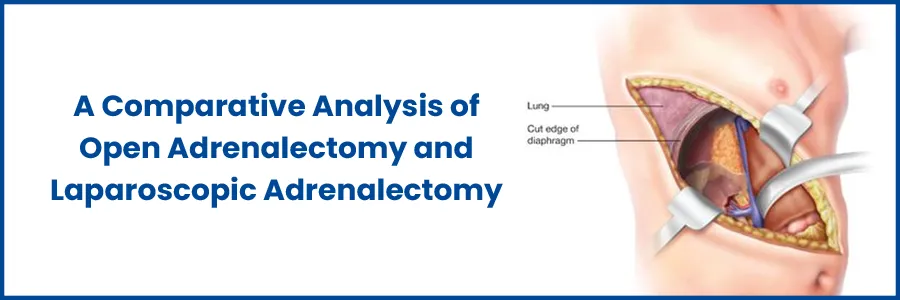- Cardiology 84
- Dermatology 45
- Endocrinology 33
- ENT 16
- Fertility 190
- Gastroenterology 78
- General-Medicine 81
- Gynecology 80
- Hematology 19
- Infectious-Diseases 33
- Neurology 52
- Oncology 34
- Ophthalmology 23
- Orthopedics 69
- Pediatrics 31
- Procedure 23
- Public-Health 144
- Pulmonology 59
- Radiology 8
- Urology 68
- Wellness 161
- Woman-and-child 77

Overview: Open Adrenalectomy and Laparoscopic Adrenalectomy
This research study explores the comparison between two widely used surgical techniques for adrenal gland removal: open adrenalectomy and laparoscopic adrenalectomy. The aim is to provide an in-depth understanding of their advantages, disadvantages, outcomes, and considerations for medical practitioners and researchers in endocrine surgery.
Introduction
- Overview of adrenal glands and their role in the endocrine system.
- Explanation of the necessity for adrenal gland removal.
- Introduction to open adrenalectomy and laparoscopic adrenalectomy as surgical options.
Secure your health with a second opinion. Make informed decisions and book your appointment today!
Get A Second OpinionOpen Adrenalectomy: Techniques & Considerations
- Detailed description of the open adrenalectomy procedure.
- Historical development of open adrenalectomy.
- Patient selection criteria for open surgery.
- Analysis of advantages and disadvantages, including visibility, tissue manipulation, and incision-related complications.
Laparoscopic Adrenalectomy: Techniques & Considerations
- A comprehensive explanation of laparoscopic adrenalectomy technique.
- Evolution and advancements in laparoscopic adrenalectomy.
- Eligibility criteria for laparoscopic approach.
- Evaluation of benefits and drawbacks, such as minimally invasive nature, instrument limitations, and learning curve.
Comparative Analysis
- Comparison of surgical steps and intricacies for both procedures.
- Review of clinical outcomes, including operative time, blood loss, postoperative pain, hospital stay, and complications.
- Analysis of long-term effects, such as recurrence rates and patient satisfaction.
- Examination of the impact on endocrine function and hormonal changes for both techniques.
Factors Influencing Technique Selection
- Discussion of patient-related factors affecting the choice between open and laparoscopic approaches.
- Consideration of tumour characteristics, patient comorbidities, and surgeon expertise.
- Illustration of the shared decision-making process between the medical team and the patient.
Ready to take control of your health journey? Book your appointment now and start your path towards wellness today!
Book an AppointmentFuture Directions and Innovations
- Exploration of emerging technologies and techniques in adrenal gland surgery.
- Prediction of potential trends in surgical approach selection.
- Highlighting ongoing research areas aimed at improving patient outcomes and surgical procedures.
Open Adrenalectomy vs Laparoscopic Adrenalectomy
| Feature | Open Adrenalectomy | Laparoscopic Adrenalectomy |
|---|---|---|
| Procedure | Involves a larger incision to access the adrenal gland, typically through the flank or abdomen. | Utilizes small incisions and specialized instruments inserted through ports in the abdomen. |
| Advantages |
|
|
| Disadvantages |
|
|
| Operative Time | Typically longer due to the complexity of open surgery. | Generally shorter due to the minimally invasive nature of the procedure. |
| Postoperative Pain | May experience more pain due to larger incisions and tissue trauma. | Generally, there is less postoperative pain due to smaller incisions and reduced tissue disruption. |
| Hospital Stay | Longer hospitalization is often required for recovery. | Shorter hospital stay, typically requiring less postoperative care. |
| Recovery Time | Longer recovery period is needed before returning to normal activities. | Faster recovery, allowing for a quicker return to daily routines. |
| Complications | Higher risk of infection, blood loss, and wound-related issues. | Lower risk of infection and less likelihood of wound complications. |
| Long-term Outcomes | Effective for large tumors and cases requiring extensive tissue manipulation. | Equally effective in tumor removal with favourable long-term outcomes. |
| Patient Eligibility | Suitable for a wide range of adrenal conditions and tumor sizes. | Limited to smaller adrenal tumors and certain patient criteria. |
| Surgeon Expertise | It requires extensive surgical experience and skill due to its complexity. | Requires specialised training in laparoscopic techniques for optimal outcomes. |
| Cost | Often more expensive due to longer hospital stays and surgical complexity. | Initially higher equipment costs but may reduce overall healthcare expenses through faster recovery and shorter hospital stays. |
Frequently Asked Questions
Open adrenalectomy involves making a larger incision to access the adrenal gland, while laparoscopic adrenalectomy is minimally invasive and uses small incisions and specialized instruments.
Generally, laparoscopic adrenalectomy is associated with shorter hospital stays, reduced postoperative pain, and quicker overall recovery than open adrenalectomy.
Patient eligibility for laparoscopic adrenalectomy depends on factors such as tumor size, location, and the patient's overall health. Consultation with a surgeon is essential for proper assessment.
Both methods can potentially impact endocrine function, but the extent and nature of the impact vary. Surgeon experience and patient characteristics play a role in determining the outcomes.
The future likely involves continued refinement of laparoscopic techniques, incorporating robotic assistance, and advancements in patient-specific treatment plans to optimize outcomes.
The decision is influenced by patient factors, tumor characteristics, and surgeon expertise. A collaborative discussion involving the medical team and the patient helps determine the most suitable approach. This comprehensive analysis aims to provide valuable insights into the choice between open and laparoscopic adrenalectomy, offering healthcare professionals and patients a better understanding of the benefits and considerations associated with each technique.

- Cardiology 2132
- Dermatology 168
- Endocrinology 135
- ENT 97
- Fertility 217
- Gastroenterology 232
- General 478
- General-Medicine 1685
- Gynecology 169
- Hematology 85
- Infectious-Diseases 208
- Neurology 207
- Oncology 345
- Ophthalmology 65
- Orthopedics 187
- Pediatrics 83
- Procedure 72
- Public-Health 209
- Pulmonology 126
- Radiology 13
- Second Opinion 311
- Urology 294
- Wellness 600
- Woman-and-child 447
- Others 10217
Related Blogs
If you have any questions, please fill out the enquiry form or call us, and we will get back to you promptly.
040-68334455